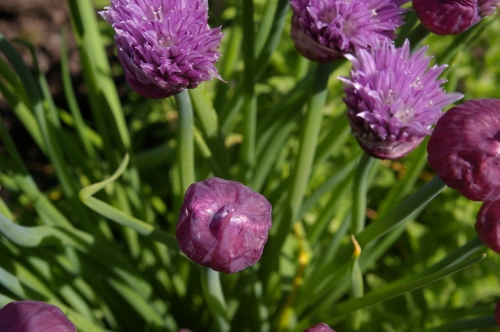
I met Alex in one of the public urban gardens where I took pictures of the flora. Here some chive blossoms.
My life has become so busy that back in April (yes, April!) I decided that for my birthday I wanted to do more exploring of the urban jungle, my city’s back yard. It would be a bit of discovery, a bit of a lovely stroll with friends and a bit of unearthing what it is we leave behind.

The first find; a glittery sequined pine cone.
Do you ever wonder what archeologists of the future will find when they dig through the layers of earth? Will it be a Pompeii, with so much intact from a sudden disaster that catches everyone unaware? Will it be like Roanoke, Virginia, where a whole town up and left suddenly (or so it looked) that dishes and food were left on the tables? These are some of the mysteries discovered when we sift through the dust and debris of yesteryear. What will those lost artifacts tell the future about how we lived?
I was inspired to try out some modern day urban archeology by friend and fellow writer Alex Renwick, who had several found objects cases in her place with an array of interesting items. There were the natural wonders she collected (shells, stones, sticks, etc.) plus pieces of glass, or dolls or other things lost and abandoned along the way.

We did not dive into the dumpsters but chose from near them.
As it turned out, no one else thought this was a fun idea so Alex and I went on our own adventure, with Daniel and Anja joining us along the way. My goal was to pick up anything that wasn’t natural, in the alleys and streets we wandered. I soon decided that cigarette butts (the most common form of human debris that I found) and skanky rotting garbage didn’t count. I only gathered man made items, whether pretty or not.
Alex’s mandate was a bit different and she had an experienced eye for collecting. In fact, when she met me she had already found some sort of sequined bauble. She also gathered natural debris such as twigs, berries and stones, plus a plethora of flattened bottle caps. Her collection was definitely more arty than mine.

Anja’s collection included a bright fuschia flower, nails, and a disc with an urban angel.Enter a caption
The first thing I found was that my romantic image of great old chair legs and pieces of dolls was not going to happen. All of Vancouver’s alleys are paved over and overall, Vancouver’s a very clean city. For the future there would be better areas for debris, such as along train tracks. I’ve discovered in my goal of walking more this year that there are a lot of homeless people who hang out and live under the elevated SkyTrain tracks but considering the squalor of those areas it’s probably better not to wander into that area.

Daniel’s items centered on plastics and that silver pack is a David’s Tea bag.
We did two different areas, with a long walk through some urban gardens where there are old tracks, but not quite as destitute because people grow their plants and veggies along the way. In fact Anja found the most interesting artifact in this area, mostly buried into the ground; and angel plague.

My objects, laid out like specimens, with the flowering begonia. fake flowers, broken glass, a toy mouse and plastics.
We had a lovely day for doing this, saw some great gardens and plants,explored various streets and spent time in companionship. Not to mention that we did a bit of recycling for the city. Once we’d gathered our various bits, we laid them out for documenting and then they were recycled. Alex and I both kept some of our pieces. I found a full flowering begonia in one alley and still have it, with a few yellow flowers, though the frost is coming so its days are numbered.

Alex’s treasure trove, including the sign that says Paperback Cellar. Lots of plant material and artfully arranged.
Since then I have found some of the thoroughfares have the most garbage; abandoned tags and bus tickets, plastic and Starbucks cup, numerous cigarette butts and a myriad of wires and string. In fact, none of these are in the collections shown here and was what I noticed in my walks downtown. But I’ve been inspired. I believe that next spring I’m going to start collecting some of these items, yes, even the cigarette butts. This means I’ll have to carry gloves and other containers for such disgusting castoffs. I have several ideas for making urban art, which will be both a social commentary on what we consume and what we throw away.
In the meantime, it was a fun way to explore the city and I hope we can do a few more urban archeology projects when spring returns. Below, a little slideshow of our day, with a yard that was designed on found objects.
All photos copyright Colleen Anderson. Alex Renwick for Paperback cellar images.


























